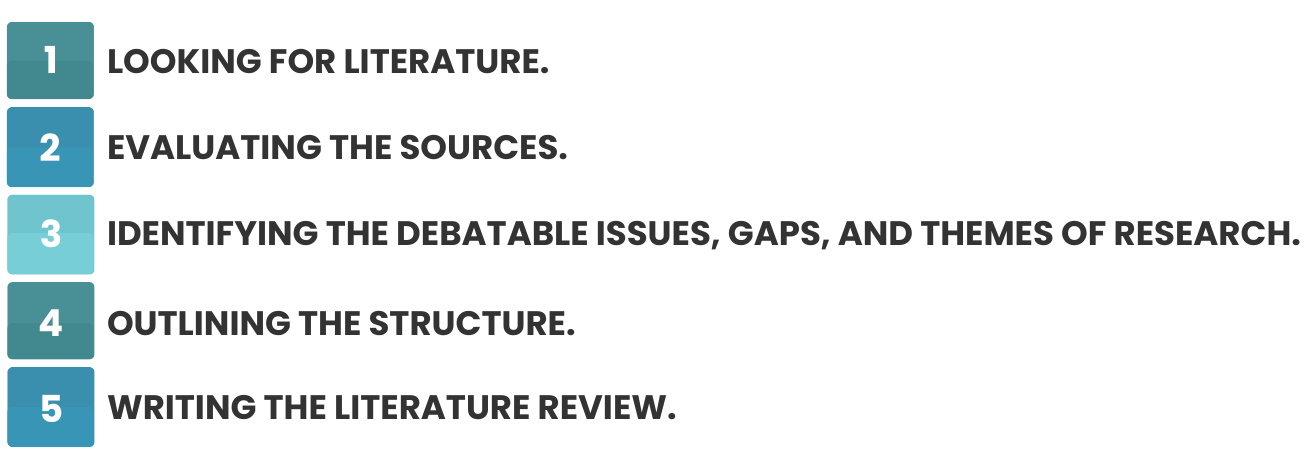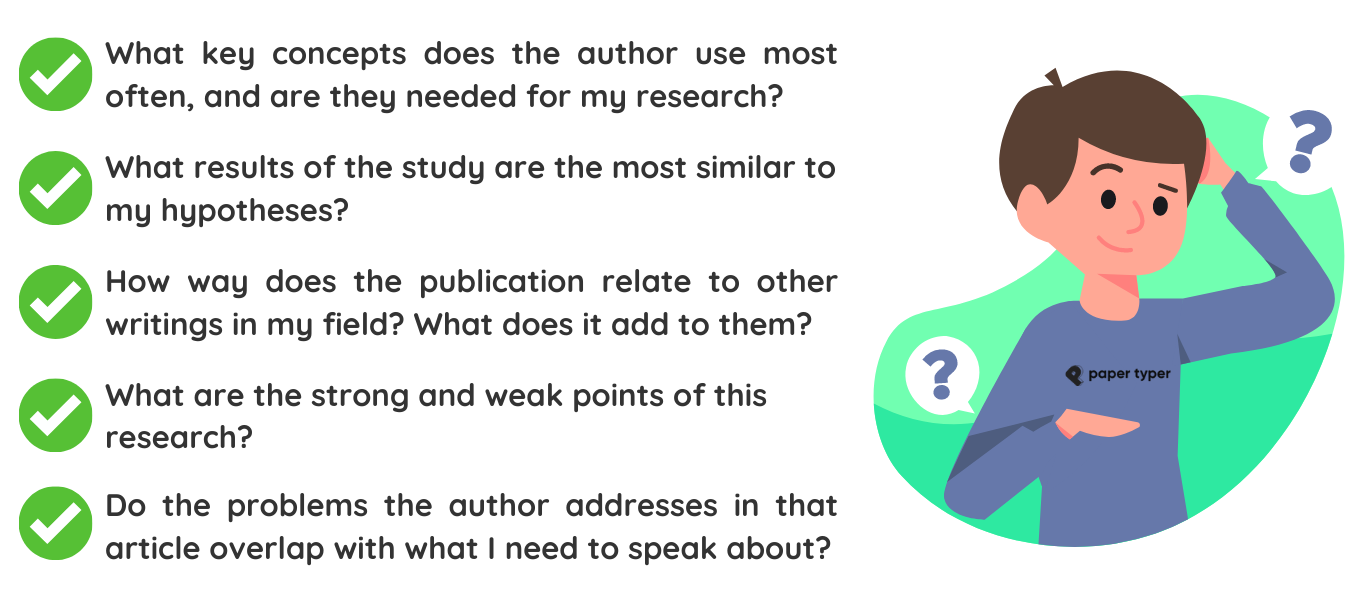How to Write a Literature Review
To overview the current sources on a certain scholarly topic and determine the related theories and methods, we write a literature review. This type of academic writing also allows you to identify the gaps in existing knowledge on the subject of interest.
To start a writing process, you need to find the relevant publications on the topic and critically analyze them. Then, you explain what you have found by making the following steps:

A good review is not about summarizing sources only. It is about their analysis, synthesis and critical evaluation to complete the overall conclusion about the available knowledge of the theme and its perspectives.
Why We Need a Literature Review
This type of academic writing is needed when you write a research paper, thesis, or dissertation. It is required to better understand the place of your research in this field. You have to:
- show how much you are familiar with the theme and context;
- find your place amidst other theorists and researchers of the same topic;
- identify your methodology and theoretical framework of the future research;
- demonstrate in what way your research can fill in the gap or add something new to the debate.
A literature review can be a stand-alone assignment too. You just have to consider the current gains in this part of research and view the main characteristics of the debates on the topic you are aware of.
These are two different tasks, so their content differs a bit, but the entire writing process is the same.
If you want to enter graduate school or continue your research and scholarly career, your awareness of how to write a literature review is important.
Looking for the Corresponding Literature
To start your search for the literature, it is vital to know the exact topic. The purpose of writing the review also matters a lot. If you are going to write a research paper or dissertation, you should know your research question or problem.
If your literature review is a separate assignment, you just pick out the main problem and look for everything that is related to its question. This question can be answered without any deep search in the original data. You can respond to it only by analyzing the topical publications.
List of Keywords
You can start with a list of keywords on the question you need to research. You can include here any concept or variable you are interested in. They can be synonymous terms or some words related to them. If you come across some new concepts within the research process, you can add them to the list.
Sources That Relate to the Topic
You can use the keywords for searching for sources. There are useful databases where you can see the articles and journals that are interesting for you. For example, you can opt for Google Scholar, Project Muse, JSTOR, or your university’s online library.
Good to know
You can narrow down your search by introducing the following words in your search engine:
- OR - for looking for the information by using synonyms;
- AND - when you need the search with two or more keywords;
- NOT - you can exclude some terms from the search which are not your objects of interest.
You may look for articles, books, or authors you have already cited in your dissertation. If they have appeared in it more than twice, they are worth looking at to continue research.
Evaluating Sources for The Better Selection
You can try to answer the following questions:

All the sources you intend to use in your review should be credible. It means that they represent the major theories in the field and are widely recognized.
Google Scholar can help you see how many times the publication has already been cited. It shows how influential the article is.
The size of your review and its content depends much on the field of your study. You can use only the recent publications in the sciences. Though, the humanities allow for a longer historical perspective.
Taking Notes and Citing Sources
While reading the sources, you can already begin your writing. Try to take useful notes which can be further incorporated in your review or the paper you are writing.
Be attentive about avoiding plagiarism. So, you need to keep track of all the citations. That will help you remember where you read about the idea and not present it as your own.
For the correct citation format, you can use our free Citation Generator and Plagiarism Checker to ensure that your work is unique.
Determining Themes, Gaps, and Debates
To start structuring your literature review, try to understand how the sources you have found are connected. Identify:
- Themes - whether they recur in all the publications.
- Patterns and trends (related to methods, theories, or results) - whether they are more or less popular over time.
- Gaps - concepts and findings missing in the literature you are reading.
- Contradictions and conflicts - whether all the sources support the same idea or how they contradict it.
- Influential publications - those that have probably changed the course of the field.
During this process, you will make up the structure of your review and understand how your research can contribute to the field.
Outlining the Structure
It is crucial to organize the body of your literature review correctly. You need a strategy on how to do it. You can use the following:
- Chronological order.
Tracing the research of the topic over time is easy. However, avoid simple listing or brief summarizing. Focus on patterns, important concepts, and debates present at different periods. Interpret the facts to understand why these ideas occurred. - Thematic approach.
Find the main themes which are repeated in most writings. Your review, in this case, can use the subsections to highlight different aspects. - Methodological findings.
You can use this approach if your sources are taken from different fields of study. All of them may use various research methods so you have to compare the results obtained from these multiple approaches. For instance, decide whether quantitative or qualitative research has been used, if the topic was regarded from a practical or theoretical point of view, or what kind of source it is - a historical, sociological, or cultural one. - Theoretical approach.
Make your literature review a base for a theoretical framework. Discuss different models, definitions of concepts, and entire theories. You can combine various theoretical concepts for making the framework that will most perfectly suit your purpose.
Writing the Review
A literature review should have the introduction, main body, and conclusion. You can include the ideas in each part of it that are related to the review’s objective.
Introduction
Set up the main idea and purpose of your literature review clearly. Indicate whether it is a part of your academic work or a stand-alone piece of assignment. Provide the background of the chosen topic as well.
Body
You can divide the body into several subsections. Use subheadings if required. They can demonstrate the theme, methodological approaches, or timeframes.
You may use the following tips to make the writing process easier:
- Summarizing and synthesizing - here is the overview of the main ideas of each source in correspondence with your theme.
- Analyzing and interpreting - paraphrasing other scholars will not work: you should add your interpretation or discuss the importance of the findings for your research.
- Critical evaluating - your sources have their strengths and weaknesses so indicate them all.
- Well-structured paragraphs - using transition words to connect, compare, and contrast different writings and their ideas is essential; try to make topic sentences consistent.
Conclusion
Here, you need to sum up your key findings represented in the literature you have considered. Try to focus on their significance for the overall field development and for your academic paper. You can also make suggestions about their influence on future research work in this field. Show their importance for filling in the blanks in research.
Final Thoughts
Now, you have finished writing your literature review and are sure to understand how to write it. Reread it and revise the content. Proofreading is important to avoid unnecessary grammar and spelling mistakes and typos. Check whether your writing is consistent, corresponds to all the criteria and requirements to this type of academic writing.
You may need to write this article again at the end to make sure that you have followed all the structural instructions and your literature review deserves the highest grade.
